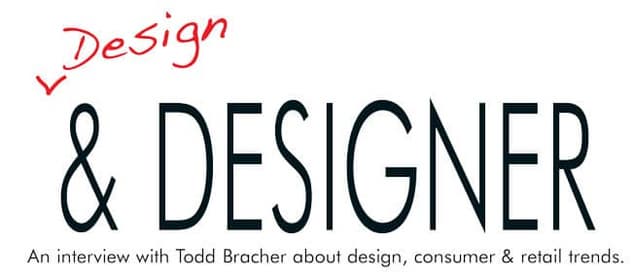
Visiting a furniture store has to be holistic, with every touch point supporting every other one to create a fully integrated experience."
We are used to the idea of essences formulated from plants that we use for flavorings or in perfumes. When, however, we come up against a design philosophy of essence, we might be challenged by both the concept and the realization.
Todd Bracher, an award-winning designer, is adept at finding the essential properties of design. Brooklyn born, Todd was graduated from Pratt Institute’s industrial design program in 1996. After earning his MFA at the Danish Design School in 2000, in interior and furniture design, he went on to work and study in Milan, and Paris. From there Todd moved to London to help set up Tom Dixon’s office where the influential Tom Dixon brand was formulated.
Bringing his global design language back home to Brooklyn, Bracher founded the Todd Bracher Studio, where he is the creative director. His expertise as an industrial designer and design strategist has been recognized by Wallpaper* Magazine in 2015 and 2017, and as FX Product Designer of the Year in 2015. Todd was selected by imm cologne to create the 2017 Das Haus exhibit, which he titled The Essence of Living.
Furniture World: First of all, tell us about your approach to branding and furniture design.
“About 50 percent of our business is what we call strategic design. The other half is creative direction," Todd replied. "Basically, this requires us to work with our clients to reach new markets and grow their revenue. We rarely do the kind of product design that comes from a company wanting us to design something and just walk away. Historically we did a lot of directed design work, but over time we moved away from that once we realized that many of our clients didn’t really know what they needed."
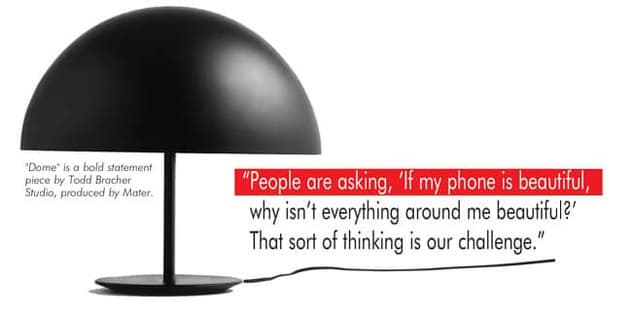
Todd went on to explain, “Companies may fall out of touch with their markets over time. We found that we are good at helping them become more relevant by providing insights into their businesses, supply chains, and distribution. We then connect that to a new audience. It’s behind the scenes, strategic work – moving the chess pieces around – and then on top of that, delivering product design that is on message.”
Truthful Design
Furniture World: You have said that you strive to create ‘truthful design that isn’t arbitrary, not cosmetic.’ What do you consider arbitrary design and how do you avoid it?
Todd explained that he starts his work with the premise that very few people care about his opinion. “There are plenty of designers who create home furnishings by adding their personal points of view as a starting position.
“For example,” he observed, “if you look at two cars sitting next to each other, you may instantly form an opinion about each car’s attachment to a place, a time and whether you like one better. For me, that’s arbitrary design: it is too connected to a place, a time, and a person.
“A natural object, such as a tree, is less subject to analysis with respect to time, place and preference. Nature’s objects are truthful results of an ecosystem, not a stylization of someone’s opinion.
“What I am trying to achieve is truthful design, which can also be thought of as science-driven design. This was the approach that we used to create ‘Vessel’, a single quartz glass rod containing an LED. What made this design unique is that the physics of light determined its form.”
Bracher consulted with an optical physicist to create Vessel. The design process began by describing the basic dimensions of the piece and its function – where the light needed to start and finish, plus how emitted light needed to fall to properly render food and people. “Then I asked the physicist, ‘What does that look like?’ And he quickly created an image of a design that would control light in the way I described.
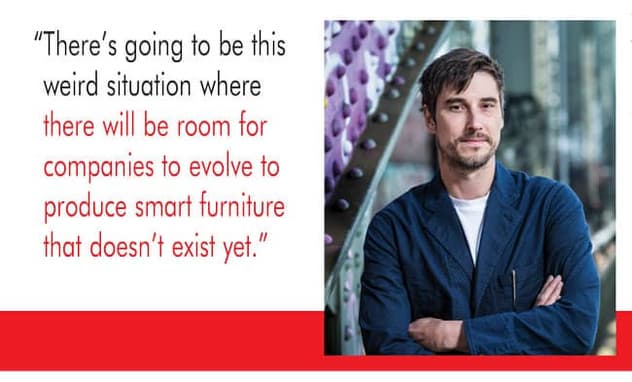
“Light is 100 percent predictable. It’s physics, so there’s no guess work. Using nature as a primary consideration in the creative process results in truthful solutions to human design challenges.”
Furniture World: Your design, therefore, removes time, place, and personality – becoming almost organic. So, what considerations do you incorporate?
“Strategic design considerations include cost, material, tooling restraints, market need, user need, and much more. We line up a million things that this one product needs to do. The goal of the design is to create it in one gesture. That’s what makes it poetic, and why people fall in love with it. Otherwise, it’s just an object sitting there."
Furniture World: So you are going for a Platonic ideal of truth and beauty?
“Yes, I think that creates a true connection,” Todd explained, “If it’s Todd’s opinion about beauty, some will like it, but some won’t. Again, there are plenty of folks who can do more beautiful things than I can, and that’s fine. But what we do is try to address a user’s real need in such an authentic way that the result, by definition, will be beautiful.”
Furniture World: In other words, there is no need to gild the lily – your work does not have a lot of ornament to it.
“That’s right. There isn’t ornament in a decorative sense – in an arbitrary sense – but we don’t go to the other extreme,” Todd clarified. “I’m not suggesting that either. So just to be fair, it’s not like everyone’s got it wrong. You might enter my home and find decorative objects that I think are meaningful. There has to be a cosmetic component. That can’t be denied. If what we deliver works beautifully well but looks awful, we’re going to rethink it.
“From my perspective,” he continued, “we need to find a way to have that cosmetic component be universal and timeless. Otherwise we’re doing our customers a disservice. It costs a lot of money to get home furnishing designs to market; there’s a lot of material and manpower. If a design is going to be dead in two years because nobody wants ‘the silver thing’ anymore, we’ve failed. When I walk the halls of furniture shows, I find myself imagining the amount of items shown that either won’t sell or will get thrown out prematurely. I do not want to be one more person to contribute to that.”
“George Nelson, Charles Eames and Eero Saarinen did not create designs based on style and fashion,” Todd explained. “Their creations were based on the same logic we’ve been discussing. The funny thing is how the style world picked up their ideas and tried to spin them years later. It worked, but the core of it was not arbitrary it was based on truthful solutions.”
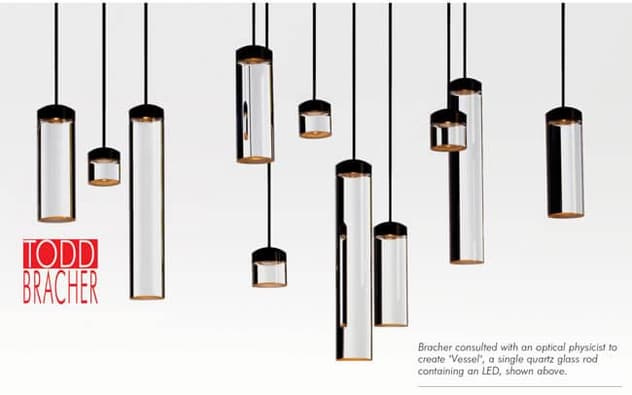
Design Process
Furniture World: When working on a design do you do focus groups, or just wait for the solution to come to you?
“Neither,” Todd corrected. “We do a lot of market research. We combine surveys and interviews to understand what people are looking for, what they need. Then we line up opportunities we think folks have missed.
“Let’s say a client wants us to design a space for eight people who will do a specific activity. We don’t start with a cool shape. We start by developing an ecosystem of needs, and from there we arrive at, for example, how a chair needs to look. And we know it will work not just for our client, but also for an industry of people that need it.
He continued, “The other half of my business focuses on everything that needs to happen after we make the product.”
Furniture World: How important to furniture marketers is having a powerful story that goes with their products?
“A story causes someone who is looking at a design to think, ‘Yeah, that’s a meaningful need of mine.’ And that’s the same story we, as a design firm, use to create products from the beginning. It’s not something we add on top. It’s the actual engine that created it.
“In advertising and marketing, for example,” Todd continued, “there can be a lack of understanding of why something is meaningful; why people need a product in their lives. That’s a common problem. A product that’s brilliantly designed but not well photographed, or well communicated, won’t sell. It’s a wasted effort.
“Tom Cargill of Bell Labs, speaking humorously about programming code said, ‘The first 90 percent of the code accounts for the first 90 percent of the development time. The remaining 10 percent of the code accounts for the other 90 percent of the development time.’ And I feel like that’s really the same condition we find when we do design. We deliver 90 percent of it, and then it’s up to the sales folks to then complete their big 10 percent. That 10 percent is the biggest piece, if you ask me. A lot of things die there because sales teams are not equipped to deliver that big 10 percent.”
Essential Defined - Das Haus
Furniture World: You were selected from among internationally known designers to create the installation for imm cologne’s Das Haus exhibition in January 2017, you titled: The Essence of Living. The whole concept seems to represent your philosophy of design. What did you hope for visitors to take away from this year’s Das Haus?
“Das Haus,” Todd began, “is an interpretation of a residential house. You might walk in and ask, ‘Where do I put my coat?’ or ‘How do I fry an egg?’ and my answer would be, ‘Well you can’t.’ Not everything in this concept house was fully resolved.
“If you are in Denmark and ask someone where their grandmother is from, they will say, ‘Denmark, of course.’ Asking the same question in France will most likely get a similar reply. These are fairly homogeneous cultures. America, however, is different.” The implication is that a Danish visitor to Das Haus, or a French or American visitor will look at the installation in different ways."
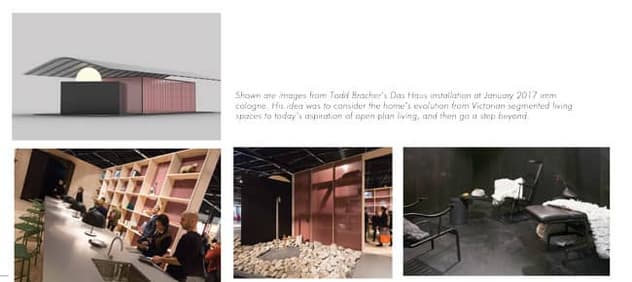 Furniture World:
Furniture World: So how might someone from the US or Canada interpret Das Haus?
“I think I struggle with what it means to be American, especially in a global context. American living is over-saturated. It can be just too much. I live in New York City, have two kids, and the lifestyle is kind of ridiculous. Regarding our houses, I think we need to take a step back.
“When you buy a house,” he explained, “you’re buying a legacy of someone else. You’re buying a structure that was designed by and for someone else. Does it pertain to you? Maybe it does, and that’s totally okay, but maybe it doesn’t.
“Designing Das Haus, I decided not to put in a bed with two nightstands and two lamps on them. Why do we need those things? Is it because it is shown in magazines that way? Do most people question if they need a dining room in their house? Why not ask, instead, if they need a room for quiet, or for creation, or destruction? What doesn’t make sense is to have a room that stays empty called a dining room because you think you’re supposed to.
“In the West, we aspire to what is called ‘open-plan living’. Victorian homes were very segmented, room by room, with lots of doors, difficult to navigate. Open plan living is in some ways the antithesis of Victorian living.
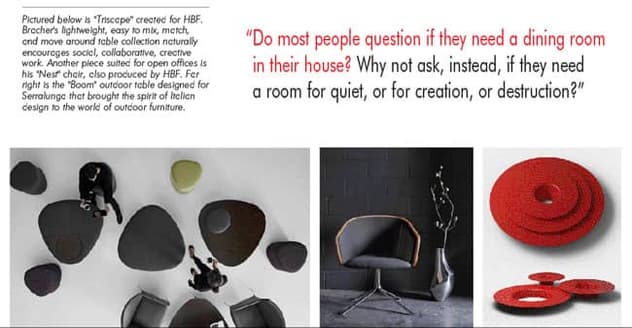
“As Das Haus started to evolve, we considered the home’s evolution from a Victorian-segmented life, to the aspiration of open-plan living, and took the next step. That’s what Das Haus is about.
“Instead of blurring the zones,” Todd continued, “we combined them. We questioned the need for creating the perception of a division using a half-wall to divide a living room from a kitchen. Why not just combine them? What’s the need to have a separate room for study or a home office. Why aren’t they in the same space?
“Das Haus is divided into a couple of zones. Basically, the thought is that the kitchen is no different than the living room, which is no different than the library. Each of these is about sustenance, it’s all eating. One area is for mind, one is for body, and one is for spirit. That’s the way I’ve broken it down. So why not just put those together?
“In Das Haus there’s a room for sustenance and another room for rest. We didn’t include a separate bedroom because there’s more to rest than sleeping. There’s also daydreaming, thinking and meditation. In Das Haus there is furniture in that space to facilitate all those functions. There is also an outside area for hygiene, a space to reconnect with the environment, with nature, while washing."
He concluded, “That’s effectively the broad brush of what Das Haus is. I set out to interpret what we really need in our lives, take a step back, and put those things into this house – nothing more. We disassembled traditional notions of what home is and put them back together. We’re not saying this is how everyone is going to live 18 months or seven years from now. It’s just a mathematical result of the trajectory that we’ve been on as a culture."
Design Leadership
Furniture World: Where do you see transformative home furnishing design leadership coming from?
Todd responded, “Companies like Nest, Apple, Google, and Amazon are where it’s coming from. There’s a huge divide between where our industry is today and the Smart Home. It’s a tremendous gap. Buy a Nest thermostat, and it will make everything else look dated. I believe the industry is going to start to catch up. It has to converge because technology is going to move a lot faster and deeper into our homes.
“That’s what most companies are going to struggle with. We are not technology companies. We are about plywood and upholstery. There’s going to be this weird situation where there will be room for companies to evolve to produce smart furniture that doesn’t exist yet. That will create a divide within our industry that will be really interesting to see. Everything in our homes is going to be smart. Today furniture is still just dumb. It doesn’t make sense to me. There’s going to be a point where things will cross over.

“Let’s also consider the whole trend toward consumers installing industrial, professional kitchens,” Todd mused. “Will a version of that happen in the living room? Certainly people feel they don’t need a formal dining room anymore. The question is, who will handle that? Is there an opening for Google to make smart sofas? I don’t know, but I think we’ll be looking at a whole new landscape, done in a qualitative, high-end way.
“The iPhone, for example, helped create an expectation that products should be fully resolved and beautiful. There’s no more room to have screws showing, and things being kind of sloppy. The bottoms, backs and insides of products, including home furnishings will need to be beautiful,” he predicted. “A trend toward beauty and simplicity is becoming stronger than ever. People are asking, ‘If my phone is beautiful, why isn’t everything around me beautiful?’ That sort of thinking is our challenge, and my spin on where the whole home furnishings space is moving.
Case For Sustainable Design
“Design leadership must also come to terms with the need for sustainability. I helped start a furniture company in Denmark, called Mater, which means ‘mother’ in Latin. The company’s focus is on the process we go through to make furniture, while also improving the environment.
“Instead of seeking out green or sustainable suppliers to manufacture Mater’s designs,” Todd said, “we did just the opposite. We looked for companies that poured chemicals into the rivers; that didn’t have proper ventilation in their plants; had fire hazards and other unsafe or unsustainable situations."
Todd went on to clarify, “Mater was founded in Denmark where there is a codex that classifies companies as environmental offenders. We reached out to offending companies and asked them if they would like to work with us. They’d reply, ‘Well yes, but we can’t work with you because you care about the fact that we pour chemicals into the river.’ We would observe, ‘That means you can’t work with a lot of companies.’ To which they would agree.
“At this point, Mater would offer to help pay a portion of the cost to fix the problem, which created an incentive to make positive change on the supply end. Mater turned around four different factories, allowing them to work both with Mater and other similar companies in the global markets.
“The point is,” he summarized, “that the products retailers buy don’t have to save the world, but the process can pay attention to it."
Furniture World: Do you have any specific advice for our readers?
“Furniture retailers need to focus on getting their customers to feel that they want to buy an entire experience. They need to find ways to show things in collections, to display them beautifully – in ways that will excite."
Todd concluded, “This requires presenting products in a way that connects with a core audience so they get excited about being in a retail showroom. Brands need to know who they are, and to live it to their customers. The experience of visiting a store has to be holistic, with every touch point supporting every other one to create a fully integrated experience.”
Russell Bienenstock is Editor-in-Chief of Furniture World Magazine, founded 1870. Comments can be directed to him at editor@furninfo.com.